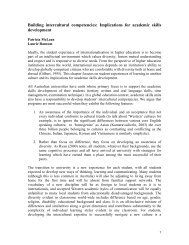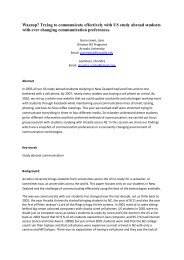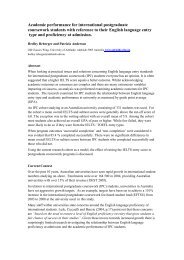Barley Breeding Australia - proceedings.com.au
Barley Breeding Australia - proceedings.com.au
Barley Breeding Australia - proceedings.com.au
Create successful ePaper yourself
Turn your PDF publications into a flip-book with our unique Google optimized e-Paper software.
13 th ABTS 2007<br />
Fremantle, Western <strong>Australia</strong><br />
The malting and brewing industries and the marketers have expressed a need to have a more<br />
coordinated approach to the re<strong>com</strong>mendation and release of varieties into the <strong>Australia</strong>n market.<br />
BBA will play a lead role, firstly through t producing “Variety Development Plans” for each<br />
program and region to enable specific and efficient future targeting and resource allocation to<br />
meet the needs of the industry. “Commercialisation Plans” for each potential release will gather<br />
and collate relevant information indicating the merit of the new line and the justification for<br />
further testing and possible release. BBA can then oversea the more orderly targeting and release<br />
of new barleys for the region/market <strong>com</strong>bination and resolve issues where similar barleys are<br />
proposed for release<br />
<strong>Barley</strong> <strong>Australia</strong>, the Malting and Brewing Industries <strong>Barley</strong> Technical Committee (MBIBTC)<br />
and Pilot Brewing <strong>Australia</strong> have important roles in this process as does BBA’s industry partners<br />
in <strong>com</strong>mercial evaluation of varieties for both the domestic and export markets.<br />
Contributions to education, training and teaching:<br />
<strong>Breeding</strong> programs and their associated research and development programs provide excellent<br />
undergraduate and post-graduate training opportunities in breeding, genetics and molecular<br />
genetics, quality, pathology and abiotic stress tolerance including plant and crop biochemistry and<br />
physiology. The outputs from gene discovery and pre-breeding programs have a direct “path to<br />
market” enabling students and research programs to focus on training to find solutions to real and<br />
ongoing problems.<br />
Exchange of Intellectual Property Rights:<br />
Sharing of equity from newly released varieties is related to the background IPR, the input from<br />
the breeding program, and the input from the various equity partners.<br />
By way of example the new feed variety WABA2288 has the pedigree; Tantangara x VB9104.<br />
As such the owners of the two parents (NSW-DPI and DPI-Vic) will have an equity share bec<strong>au</strong>se<br />
their variety or line was used in the cross. A share goes to the other equity partners DAFWA and<br />
the GRDC.<br />
There are important consequences in sharing of IP as it has the potential to even out revenues<br />
from end-point royalties (EPRs) across programs. One program cannot exploit another’s variety<br />
in a backcrossing program for example without retuning shares to the background IP owners.<br />
Exploit synergies and avoid duplication in breeding:<br />
Before the formation of <strong>Barley</strong> <strong>Breeding</strong> <strong>Australia</strong>, there were six mainstream public breeding<br />
programs. By the end of the current phase of BBA there will only be the three BBA nodes:<br />
North, South and West. In the current phase of BBA there is a transition as three of the previous<br />
programs are “wound-down”. In this phase genetic material from reselected or effectively “pure<br />
breeding” lines are progressively moved through their respective programs and promoted to stage<br />
3 and 4 regional trials. Promotion will be on “merit” with consultation between the “owners” of<br />
the advanced lines and the various BBA-nodes responsible for the carriage of the material prior to<br />
promotion to National Variety Testing trials. For example selected germplasm from the DPI-<br />
Vic, NSW-DPI and TIAR programs could be eventually promoted on merit to stage 3 trials<br />
throughout <strong>Australia</strong>. An important collegiate consideration has been to make sure material from<br />
different programs has an opportunity to be evaluated for its appropriate fit in appropriate<br />
regions.<br />
A further example of the utilization of resources across regions can be seen in the new doubled<br />
haploids produced in the DAFWA facility. Doubled haploid plantlets in “tubs” are transported to<br />
NSW-DPI at Wagga Wagga for transplanting and “growing-out” in controlled environment<br />
rooms (CERs) and/or glasshouses. In the next generation further grow-outs will be made for seed<br />
increases in the field where screening for disease and agronomic performance can be made.<br />
Guidelines for Authors - page 3







